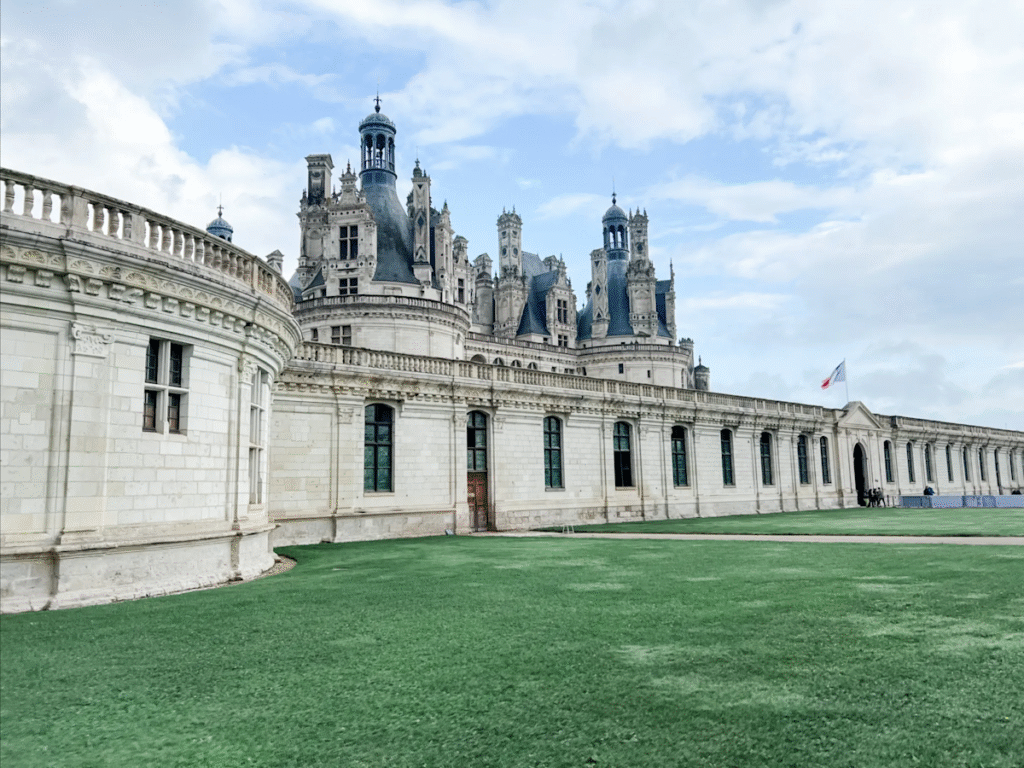Wandering through the Loire Valley in France feels like opening a fairytale book where every page reveals a vineyard-laced landscape, charming villages, and regal castles. Among the hundreds of châteaux in this storybook region, two truly steal the show: the awe-inspiring Château de Chambord and the enchanting Château de Chenonceau.
Ready to dive into their rich, royal pasts?
Château de Chambord | Where Majesty Meets Mystery
Approaching Château de Chambord is like walking into a dream. Its dramatic silhouette—marked by over 400 rooms and whimsically twisted turrets—makes it one of the most impressive Renaissance castles in Europe. Originally built by King Francis I in the early 16th century as a hunting lodge (because why not hunt in style?), Chambord oozes prestige and ambition.
Chateau Chambord
Rumor has it that none other than Leonardo da Vinci lent his genius to the château’s design—especially evident in the central double-helix staircase, which allows two people to ascend or descend at the same time without ever crossing paths. It’s as dramatic as it is brilliant, much like the French court itself.
Despite its grandeur, Chambord wasn’t a full-time royal residence. It served more as a showpiece and a place for lavish but brief stays. Still, its magnificence has left a lasting legacy.
Chateau Chambord
Chambord’s Secret Role in WWII
Chambord isn’t just a symbol of opulence; it’s also a hidden hero of World War II. When the threat of Nazi invasion loomed over Europe, art curators raced to protect priceless treasures. The Louvre’s most iconic masterpiece—the Mona Lisa—was quietly moved to Chambord for safekeeping. With its secluded location and cavernous rooms, the château became a temporary vault for France’s cultural gems.
For a brief moment in history, Leonardo’s mysterious lady with the smile watched over Chambord from within its mighty stone walls.
Chateau Chambord
Chateau Chambord
Château de Chenonceau | The Château of Women
Now, if Chambord is the symbol of royal flair, then Château de Chenonceau is the epitome of romance and grace. Built across the River Cher, this castle appears to float on the water, its reflection shimmering beneath the stone arches. It’s not just picturesque—it’s powerful. Often called “The Ladies’ Château,” Chenonceau was shaped, expanded, and ruled by a series of influential women.
It began with Diane de Poitiers, the beloved mistress of King Henry II, who added elegant touches like the arched bridge and flourishing gardens. But when Henry passed, his wife, the formidable Catherine de Medici, took back the château and turned it into a grand court residence. She added the impressive gallery that stretches across the river, making Chenonceau the striking vision we see today.
Château de Chenonceau
Catherine’s Apothecary: Beauty, Power, and Potions
Catherine de Medici was more than a queen—she was a woman of science, scent, and a bit of sorcery. Deeply fascinated by the healing and mystical properties of herbs, Catherine had her own apothecary right inside Chenonceau. Here, she blended perfumes, crafted tinctures, and dabbled in what we might call the original wellness movement.
Château de Chenonceau
Today, visitors can still explore this aromatic little corner of the castle and imagine Catherine herself concocting her herbal remedies and secret elixirs.
And while the apothecary is a true gem, I couldn’t help but be captivated by a quiet, shadowy room on the château’s third floor. There was something hauntingly beautiful about it—the view, the vibe… it just felt like home.
Château de Chenonceau
A Château With Layers of Legacy
From lavish royal banquets to its conversion into a military hospital during World War I, Chenonceau’s legacy is woven with stories of resilience, elegance, and feminine strength. It’s not just a castle—it’s a monument to the women who left their mark on history.
Which Château Should You Choose?
If you’re torn between the two, here’s a quick guide:
-
Château de Chambord is perfect if you want to feel like a king or queen roaming through endless rooms, admiring genius architecture and indulging in dramatic flair.
-
Château de Chenonceau offers a more romantic and intimate experience, rich with stories of powerful women, breathtaking gardens, and a connection to nature and mysticism.
Truthfully? See both. They each tell a different side of France’s royal history, and together they capture the magic of the Loire Valley.
Want an easy way to explore them in one unforgettable day? I highly recommend the Loire Valley Day Tour with City Wonders. The guides are charming, full of fun facts, and make history come alive. It was hands-down my favorite tour in France!
Start Planning Your Château Adventure
With over 700 châteaux in the Loire Valley, narrowing down your must-visits can be overwhelming. But if you want a taste of romance, power, history, and a little magic, Château de Chambord and Château de Chenonceau are your go-to gems.
Grab your camera, maybe a croissant or two, and get ready for a day filled with enchantment, elegance, and unforgettable stories.

